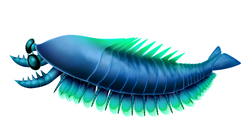| Fengzhengia Temporal range: | |
|---|---|
 | |
| Diagrammatic reconstruction | |
 | |
| Life restoration | |
| Scientific classification | |
| Kingdom: | Animalia |
| Phylum: | Arthropoda |
| Genus: | † Fengzhengia O'Flynn et al., 2022 |
| Species: | †F. mamingae |
| Binomial name | |
| †Fengzhengia mamingae O'Flynn et al., 2022 | |
Fengzhengia is an extinct genus of arthropod known from a single species, Fengzhengia mamingae from the Cambrian aged Chengjiang Biota of Yunnan, China. It is thought to be a basal arthropod, as one of the most basal members of Deuteropoda. Like other basal deuteropods, Fengzhengia has an upward curling pair of "frontal appendages" with at least 6 segments which bear endites, contrasting with the downward curving pair of frontal appendages possessed by radiodonts. The head has a pair of stalked eyes. The trunk had 15 tergites the first nine of which had upward facing spines, with the trunk terminating with a tail fan. The trunk seemingly had pairs of biramous limbs, with paddle-shaped exopods. It is thought to have been nektobenthic (swimming just above the sediment), and either a scavenger or a predator. A close relationship with the genus Kylinxia has been suggested. [1]
Cladogram after O’Flynn et al, 2023: [2]
| Total group Arthropoda |
| |||||||||||||||||||||||||||||||||||||||||||||||||||||||||||||||||||||||||||||||||||||||||||||












